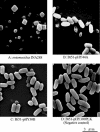Cloning and expression of two crystal protein genes, cry30Ba1 and cry44Aa1, obtained from a highly mosquitocidal strain, Bacillus thuringiensis subsp. entomocidus INA288
- PMID: 16885329
- PMCID: PMC1538732
- DOI: 10.1128/AEM.01894-05
Cloning and expression of two crystal protein genes, cry30Ba1 and cry44Aa1, obtained from a highly mosquitocidal strain, Bacillus thuringiensis subsp. entomocidus INA288
Abstract
Two novel crystal protein genes, cry30Ba and cry44Aa, were cloned from Bacillus thuringiensis subsp. entomocidus INA288 and expressed in an acrystalliferous strain. Cry44Aa crystals were highly toxic to second-instar Culex pipiens pallens (50% mortality concentration [LC50] = 6 ng/ml) and Aedes aegypti (LC50 = 12 ng/ml); however, Cry30Ba crystals were not toxic.
Figures



References
-
- Adang, M. J., M. J. Staver, T. A. Rocheleau, J. Leighton, R. F. Barker, and D. V. Thompson. 1985. Characterized full-length and truncated plasmid clones of the crystal protein of Bacillus thuringiensis subsp. kurstaki HD-73 and their toxicity to Manduca sexta. Gene 36:289-300. - PubMed
-
- Becker, N. 2000. Bacterial control of vector-mosquitoes and black flies, p. 383-398. In J.-F. Charles, A. Delécluse, and C. Nielsen-LeRoux (ed.), Entomopathogenic bacteria: from laboratory to field application. Kluwer, Dordrecht, The Netherlands.
-
- Hashimoto, N., J. Sasaki, S. Asano, H. Bando, and T. Iizuka. 1996. Bacillus thuringiensis ICP gene expression under the control of cryIA(a) gene promoter. J. Seric. Sci. Jpn. 65:185-191.
-
- Hastowo, S., B. W. Lay, and M. Ohba. 1992. Naturally occurring Bacillus thuringiensis in Indonesia. J. Appl. Bacteriol. 73:108-113.
Publication types
MeSH terms
Substances
Associated data
- Actions
- Actions
LinkOut - more resources
Full Text Sources

